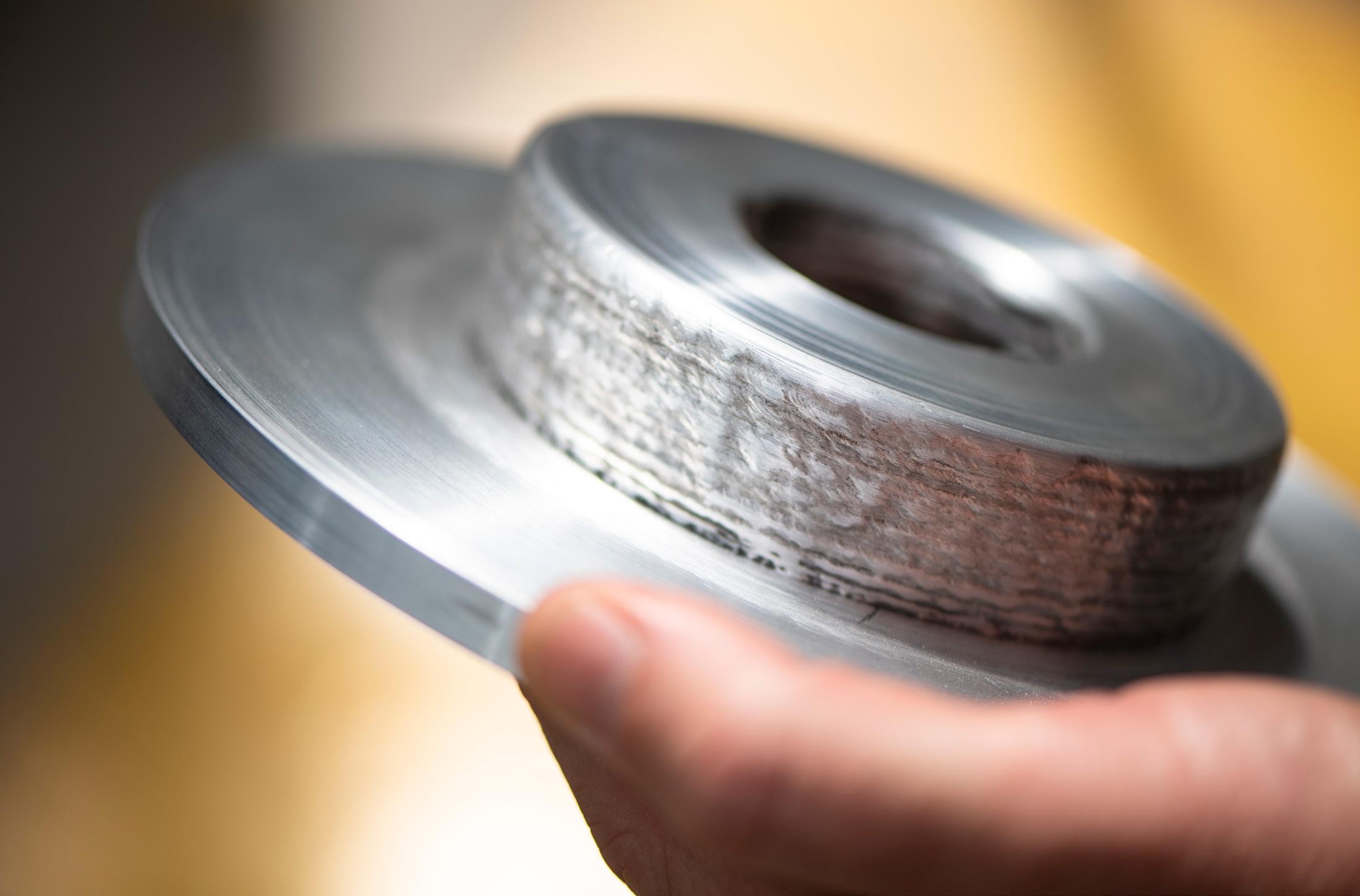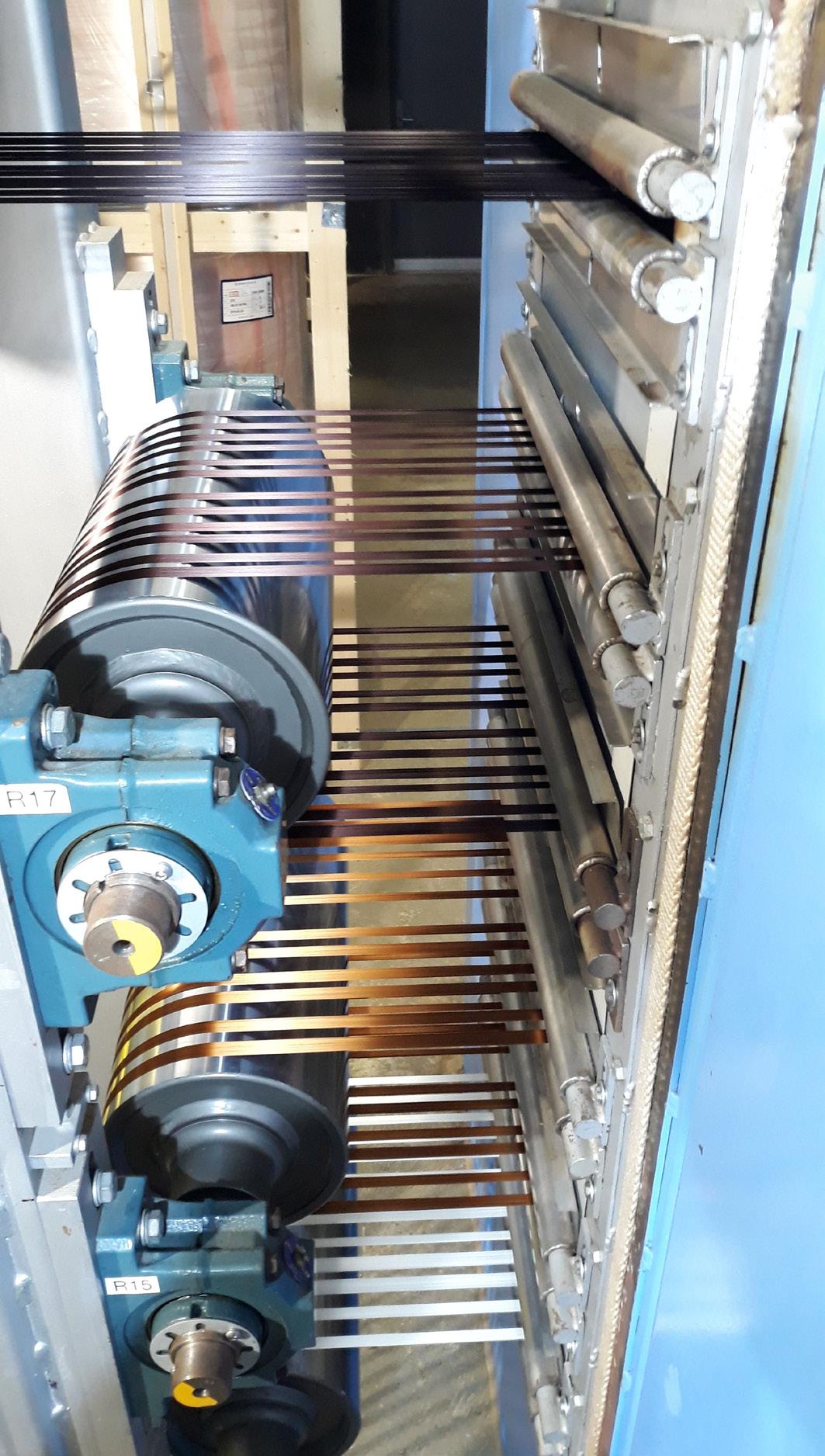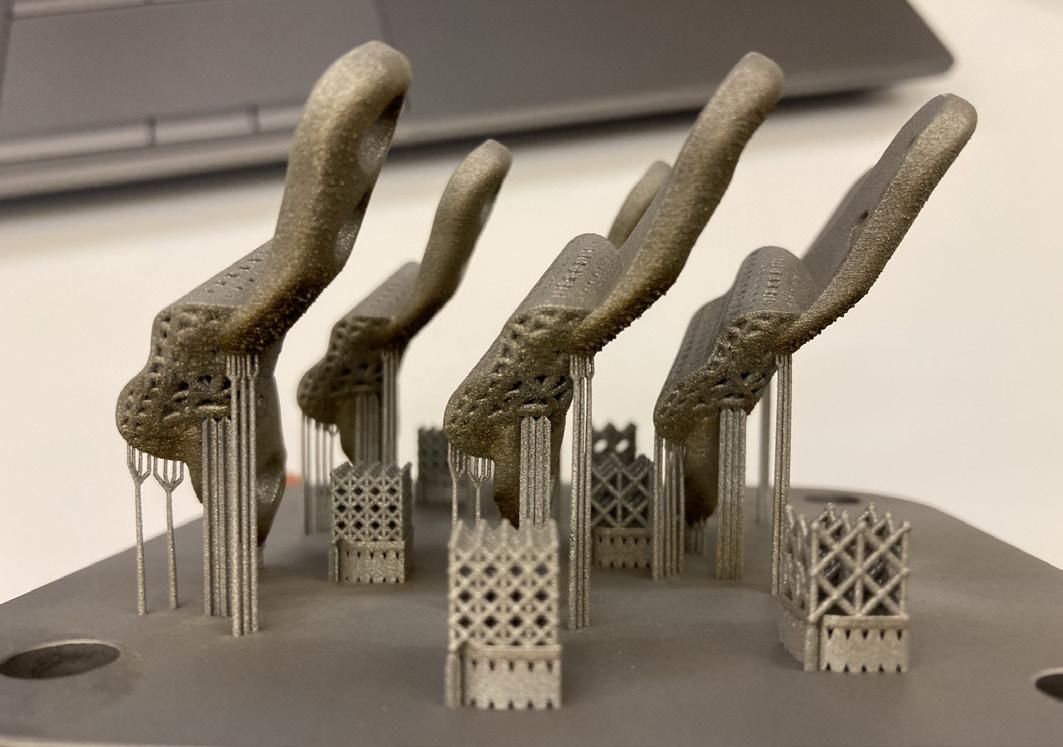
10 minute read
Advanced Manufacturing at IMCRC

Materials Science Contribution to Advanced Manufacturing at IMCRC
Source: Dr Matthew Young, Manufacturing Innovation Manager, IMCRC
2022 marks the final year of the Innovative Manufacturing Cooperative Research Centre (IMCRC) and my sixth year as Manufacturing Innovation Manager. When I joined IMCRC, only four projects had been approved for funding, with no projects started. This year, IMCRC will see the completion of a portfolio now made up of 71 individual collaborative projects representing a total investment of more than $230 million in cash and in-kind value catalysed from an original pool of $30 million in funding granted in CRC Round 17 by the Department of Industry, Science, Energy and Resources. Although IMCRC is a manufacturing focused research organisation, advanced materials and processes have been key in the foundation of the organisation and a key strength within our partner universities from Australia that researchers have focused to develop and advance Australian manufacturing Industry.
Uncovering Growth Opportunities for Industry
IMCRC was founded on three core research programs themed as 'Additive Manufacturing', 'Automation and Assistive Technologies' and 'High Value Product Development' as well as an 'Industry Transformation' education program. Guided by a set of milestones and goals outlined in an agreement with the Commonwealth, all programs were to be achieved within major industry-led projects conducted with our essential and project participants. Beyond these programs, IMCRC saw the opportunity and capacity to do more. We went to market for new projects aligned to CSIRO’s Advanced Manufacturing: A roadmap for unlocking future growth opportunities for Australia. The roadmap identifies five enabling technologies for strategic growth in manufacturing: • Sensors and data analytics • Advanced materials • Smart robotics and automation • Additive manufacturing (3D printing) • Augmented and virtual reality Providing significant overlap with the original IMCRC core research programs, these enabling technology priorities helped enhance IMCRC’s objectives. Because these priorities were independent of the six national priority areas
announced in late 2020 as part of the Government’s Modern Manufacturing initiative, all projects were assessed based on technology and commercial benefit alone. By considering industry partners’ existing and future manufacturing intentions, IMCRC operated without prejudice to the product manufactured or Australian manufacturing industry type.
A Focus on Proof of Concept and Prototype Development
Central to IMCRC’s selection of projects was targeting technologies that started at a Manufacturing Readiness Level (MRL) of 'proof-of-concept' (MRL-4) and progressed to 'prototype development' level (MRL-7). The MRL definitions are equivalent to NASA’s Technology Readiness Levels but focus more on outlining manufacturing outcomes at each stage. In the context of IMCRC, this means most technologies already exist at the proof-of-concept stage. As a result, our projects are more development than research orientated. Further, many of our research and industry partners had already established relationships to reach this proof-of-concept stage. Consequently, IMCRC’s collaborations have benefitted from mutual trust, and partners have had the confidence to invest in larger projects that run over multiple years. In 2020 the IMCRC activate initiative was launched to help Australian manufactures act and gain a competitive edge in the post-COVID world. Driving shorter - term research engagements (three-18 months) and offering matched project funding between $50,000 to $150,000, the initiative have been very successful with industry. Today, 37 of the 71 IMCRC projects are activate projects. Key to this program’s success has been the rapid pace to build, assess, grant, and contract projects which was all accomplished within a four to eight week period.

Supporting Life-Changing Advancements in Medical Technology
One of IMCRC’s longest projects involves leading medical technology company Stryker, RMIT University, The University of Technology Sydney (UTS), University of Melbourne and St Vincent’s Hospital. The five-year project is combining 3D printing, robotic surgery and advanced manufacturing to create tailored implants that improve outcomes for patients with bone cancer.
Of particular interest is Stryker’s work in additive manufacturing with RMIT. Under the project leadership of Prof. Milan Brandt, RMIT has developed lattice-structured titanium implants designed to match the behaviour of bone and allow long term integration. This work involved significant modelling and testing of lattice designs and configuring lattice generation tools to allow the automation of patient-specific implants. Corin Australia has engaged in an IMCRC project to produce antimicrobial nano surfaces or 'smart surfaces' on implants to dramatically reduce implant infection. This technology can be applied to a number of medical devices irrespective of the material. Key to this project has been the development of protocols and recipes to create the smart surfaces on Corin’s titanium implants. Researchers have used these protocols to ensure the smart surface fits with all other processes to deliver an approved medical device. This project has seen close collaboration between the University of South Australia’s materials and surface specialists and its biological science researchers to ensure surfaces are correctly prepared and characterised pre and post antibacterial efficacy evaluation. Another IMCRC project that garners attention is the use of kangaroo tendons as a xenograft material in ligament reconstruction and repair. Industry partners Bone Ligament Tendon (BLT) and Allegra Orthopaedics joined forces to develop an alternative to synthetic ligament replacements, which have a significant failure rate. As a material, kangaroo tendons are uniquely strong and long. However, to be used as a medical device, the material properties must be maintained through sterilisation and decellularisation. Beyond the ligament material, the project has also developed a 3D-printed ligament bone fixture screw made from bioresorbable Sr-HT-Gahnite. This novel material will allow for full bone integration with the ligaments and ensure the patient’s body will eventually be free of any synthetic material.
Optimising Alloys and Post-Treatments for Additive Manufacturing
Many IMCRC projects involving metals technologies are driven by the need to optimise alloys and post-treatments to suit 3D printing processes. Because these additive manufacturing processes often significantly differ from traditional cast or wrought processing, novel materials are needed. Material scientists and metallurgists working on these problems are now designing unique materials and process parameters that are less sensitive to 3D printing processes. In some cases, researchers can utilise the unique thermal or mechanical cycles associated with additive manufacturing to provide properties that match or exceed those of traditional metal processing. One project of interest in this respect has been conducted between RUAG Australia and RMIT University. The project developed an additive manufacturing process to address metal damage of aircraft components by leveraging geometry restoration, primarily Laser Additive Deposition (LAD). Researchers investigated problems associated with metal structural components without the need for traditional major structural repair or component replacement. This involved tuning the LAD processing to achieve desired microstructure, temper and residual stress and created significant insight to be applied to RUAG Australia’s repair operations for different metal types. Deakin University is working with industry partner AML3D to develop high-strength aluminium-scandium welding wire for its Wire Additive Manufacturing (WAM®) structures. By incorporating scandium, researchers hope to develop an alloy that requires minimal post-heat treatment. Once commercialised, the alloys will provide a competitive advantage for AML3D and stands to create new opportunities for Australia’s resource and welding wire sector with aluminium and scandium being converted into a value-add product. Leading additive manufacturing company Conflux Technology has used the Laser Powder Bed Fusion (LPBF) process to manufacture its compact heat exchange devices more efficiently. The devices have highly complex geometries and are more efficient than traditionally manufactured heat exchangers. Yet, the alloy compositions that are currently commercially available to additively manufacture heat exchangers lack the same thermal conductivity properties as their traditional casting counterparts. In a project with Deakin University, the partners are seeking to develop novel aluminium alloy compositions that improve the thermal conductivity performance of additively manufactured heat exchangers. These alloys will allow further optimisation of heat exchanger design and geometries for manufacture by LPBF.
Solving Global Challenges with Novel Composite Materials
IMCRC has a diverse range of projects that fall into composites materials technology, each reflecting the depth and breadth of expertise within Australian universities and industries. IMCRC’s largest project in composites has been under a partnership between global technology company Carbon Revolution and Deakin University. The project has delivered a series of step changes in the manufacturing efficiency and economics of Carbon Revolution’s unique carbon fibre composite wheel technology. The three-year research project focused on the development and the optimisation of key enabling technologies including binders, filler material and release agents. Close collaboration of researchers based at Carbon Revolution’s production facility delivered innovations that have reduced cycle times, lowered costs and developed higher performance products to support high volume production. In 2018, leading mineral processing company Mineral Technologies partnered with UTS to research solutions that will revolutionise how composite polymers are used to manufacture precision-engineered mineral separation and mining equipment. During this project, researchers have

looked to 3D printing to replace conventional open mould composites in the design and manufacture of the helically shaped gravity concentrator. Materials innovations have been combined with a product-specific 3D printing machine that has prototyped the gravity concentrator. Further, innovations in materials and 3D-printed Internet of Things sensors have been created to give insight into equivalent wear and structural characteristics for specific minerals and ore concentrations. A recent IMCRC project sees defence contractor Thales Australia collaborate with Deakin University to develop new intermediate modulus carbon fibres. The fibres will be used to overwrap metal gun barrels, resulting in a lighter product with increased precision. In addition to defence, the overwrap will also be used in prototypes for civil applications. Working collaboratively, the project team will design all aspects of fibre, sizing and resin combination to create the desired compositemetal interface.
In building and construction, IMCRC is supporting a collaboration with Boral, UTSand Southern Highland Concrete Construction to develop advanced technology for manufacturing, placing and curing novel ultra-sustainable concrete. The aim of the two-year research project is to produce and test concrete with an increased binder content of 70% supplementary cementitious materials. The new cement must meet industry requirements without disrupting current construction and manufacturing practices. If successful, this project stands to make a significant contribution to reductions in CO2 emissions within the cement industry.
Taking Innovative Surface Coating From Proof to Prototype
IMCRC has several projects focused on surface modification and functionalisation of metals, fabrics and fibres. In this field, it has been rewarding to see several projects grow from discovery and proof of concept through work conducted at the Surface Engineering for Advanced Manufacturing (SEAM) ARC Training Centre. This includes a collaboration between Swinburne University of Technology and Lightning Protection International (LPI) to further develop a range of novel materials that can be additively deposited onto lightning protection devices known as “air terminals”. Air terminals intercept lightning strikes and safely pass their extremely high currents to ground through connected ’downconductors’, thus protecting structures. With enhanced properties, the new materials will enable LPI to optimise the performance of its flagship corona (air-ionization) minimising technologies. The IMCRC project is supporting LPI to develop, integrate, and test these novel materials from industrial-level scale-up to manufacture. Under the guidance of LPI, the project also seeks to build and field test the performance of full-scale prototypes. With the support of theUniversity of South Australia’s specialist Coatings Research Group at the Future Industries Institute (SEAM-ARC Member),surface engineering company LaserBondaims to refine its laser cladding technology and develop the world’s most resilient mineral processing equipment. By assessing the wear and tear of critical mineral processing components in different settings – erosion, corrosion, and abrasive impact – the research team has been able to adjust the coating composition to the component and the dominant wear mechanism. Based on their findings, they can now take the proof-of-concept laser clad wear-resistant materials and manufacturing technologies to a prototype stage for mineral processing applications. As a metallurgist and materials scientist, it has been rewarding to help build and guide IMCRC’s projects as they run to completion. For those who currently work in industry or within research fields and collaborate extensively, it will come as no surprise that Australia punches well above its weight in materials sciences and the development of technology. Materials science is a discipline where Australia has successfully bridged the valley of death to commercialisation in a great number of technologies and applications, from raw materials processing through to high-value production. IMCRC’s partners’ R&D has contributed further to this and will put industry partners in good stead to commercialise project outcomes.




